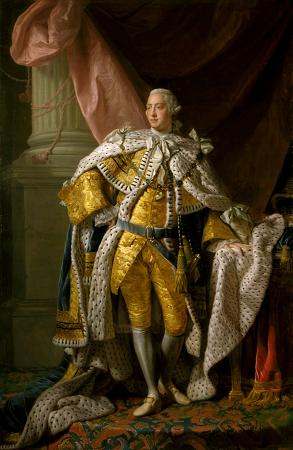George IV (1762 - 1830). George IV was King of the United Kingdom of Great Britain and Ireland and King of Hanover following the death of his father, King George III, on 29 January 1820, until his own death ten years later. From 1811 until his accession, he served as regent during his father's final mental illness. George IV was the eldest child of King George III and Queen Charlotte. He led an extravagant lifestyle that contributed to the fashions of the Regency era. He was a patron of new forms of leisure, style and taste. He commissioned John Nash to build the Royal Pavilion in Brighton and remodel Buckingham Palace, and Sir Jeffry Wyatville to rebuild Windsor Castle. George's charm and culture earned him the title the first gentleman of England, but his dissolute way of life and poor relationships with his parents and his wife, Caroline of Brunswick, earned him the contempt of the people and dimmed the prestige of the monarchy. He excluded Caroline from the coronation and asked the government to introduce the unpopular Pains and Penalties Bill in an unsuccessful attempt to divorce her. George's ministers found his behaviour selfish, unreliable and irresponsible. At all times he was much under the influence of favourites. He did not provide national leadership in time of crisis, nor act as a role model for his people. Taxpayers were angry at his wasteful spending during the Napoleonic Wars. For most of his regency and reign, Lord Liverpool controlled the government as Prime Minister of the United Kingdom. Liverpool's government presided over Britain's ultimate victory, negotiated the peace settlement, and attempted to deal with the social and economic malaise that followed. After Liverpool's retirement, George was forced to accept Catholic emancipation despite opposing it. His only legitimate child, Princess Charlotte, died before him in 1817 and so he was succeeded by his younger brother, William. George was born at St James's Palace, London, on 12 August 1762, the first child of the British king George III and Charlotte of Mecklenburg-Strelitz. As the eldest son of a British sovereign, he automatically became Duke of Cornwall and Duke of Rothesay at birth; he was created Prince of Wales and Earl of Chester a few days later. On 18 September of the same year, he was baptised by Thomas Secker, Archbishop of Canterbury. His godparents were: his uncle Adolphus Frederick IV, Duke of Mecklenburg-Strelitz; his paternal great-uncle Prince William, Duke of Cumberland; and his grandmother, the Dowager Princess of Wales. George was a talented student, and quickly learned to speak French, German and Italian, in addition to his native English. At the age of 18 the Prince of Wales was given a separate establishment, and in dramatic contrast with his prosaic, scandal-free father, threw himself with zest into a life of dissipation and wild extravagance involving heavy drinking and numerous mistresses and escapades. He was a witty conversationalist, drunk or sober, and showed good, but grossly expensive, taste in decorating his palace. The Prince of Wales turned 21 in 1783, and obtained a grant of E60,000 from Parliament and an annual income of E50,000 from his father. It was far too little for his needs-the stables alone cost E31,000 a year. He then established his residence in Carlton House, where he lived a profligate life. Animosity developed between the prince and his father, who desired more frugal behaviour on the part of the heir apparent. The King, a political conservative, was also alienated by the prince's adherence to Charles James Fox and other radically inclined politicians. Soon after he reached the age of 21, the prince became infatuated with Maria Fitzherbert. She was a commoner, six years his elder, twice widowed, and a Roman Catholic. Nevertheless, the prince was determined to marry her. This was in spite of the Act of Settlement 1701, which barred the spouse of a Catholic from succeeding to the throne, and the Royal Marriages Act 1772, which prohibited his marriage without the King's consent. Nevertheless, the couple went through a marriage ceremony on 15 December 1785 at her house in Park Street, Mayfair. Legally the union was void, as the King's consent was not granted. However, Fitzherbert believed that she was the prince's canonical and true wife, holding the law of the Church to be superior to the law of the State. For political reasons, the union remained secret and Fitzherbert promised not to reveal it. The prince was plunged into debt by his exorbitant lifestyle. His father refused to assist him, forcing him to quit Carlton House and live at Fitzherbert's residence. In 1787, the prince's political allies proposed to relieve his debts with a parliamentary grant.
more...








